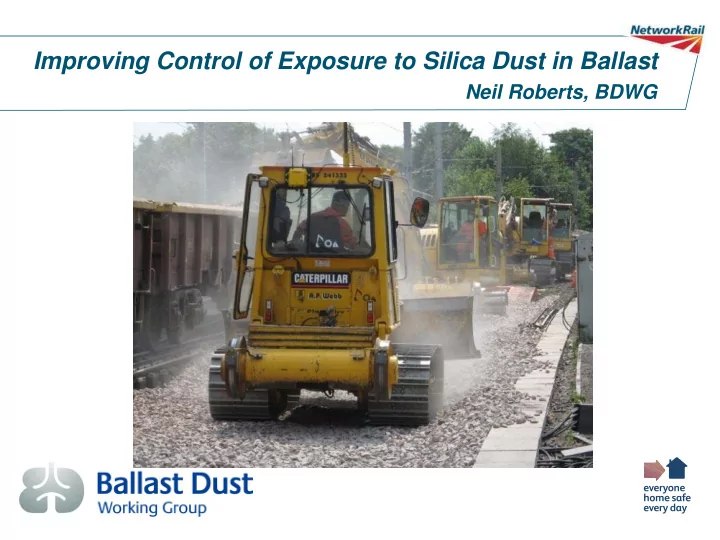

Improving Control of Exposure to Silica Dust in Ballast Neil Roberts, BDWG
BDWG – A collaborative approach
BDWG – 2013 Focus • Awareness campaign • Gather intelligence • COSHH risk assessments • Improvements • Site controls • Feedback
BDWG – Silica & Silicosis • Total inhalable • Respirable • Silica • Eyes, Nose, Mouth & Skin
BDWG – Silica Dust • Known as Respirable Crystalline Silica (RCS) or ‘free silica’ • Can be found in ballast, which is granite (20-45%) • All RCS is hazardous
BDWG – Silicosis: symptoms & factors • Chest tightness • A cough, with or without sputum • Shortness of breath • Premature death • Smoking There is no cure for Silicosis
BDWG – It’s not just about ‘health’ Poor visibility may contribute to personal accidents
BDWG – Awareness campaign • Safety Central • Trade Unions and senior management • Briefing material • COSHH assessments • Toolbox talks • Safe Systems of Work • Respiratory Protective Equipment (RPE) • Newsletter
BDWG – Poster Move away from the dust Wear appropriate RPE
BDWG – New ballast
BDWG – Quarry ballast washing
BDWG – Water dousing at LDCs
BDWG – Water dousing at LDCs
BDWG – Exposure Monitoring • Independent monitoring of 16 activities • Results so far: 10 activities monitored 3 out of the 10 indicate a significant level of respirable quartz (0.06, 0.06 and 0.08mg/m3)
BDWG – RPE Assigned Protection Factor:– FFP3
BDWG – Site Controls
BDWG – Move away if you’re not involved with the task Wear the correct Personal Protective Equipment
BDWG – Challenges • Water dousing & dust suppression • Communication • Focus • Stockpiles and wagons • Feedback – what is an acceptable level of dust?
BDWG – The next steps • COSHH • Quarries • LDCs • Site controls • Communication
BDWG – how you can help • Visit http://www.safety.networkrail.co.uk/Toolbox-for- Supervisor/National-Delivery-Service-NDS/Ballast-Dust-Working-Group and familiarise yourself with the briefing material • Communicate key messages to staff who work with ballast • Use the COSHH risk assessments • Arrange for RPE face fit testing • Review and improve site controls to help reduce dust levels • Use the feedback sheets and send them to bdwg@networkrail.co.uk
Any Questions?
Recommend
More recommend